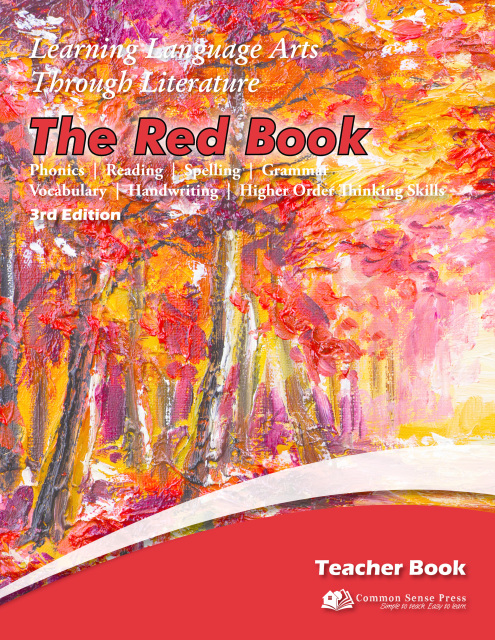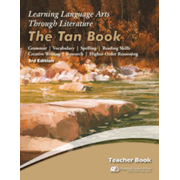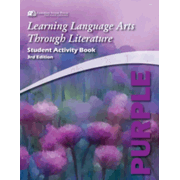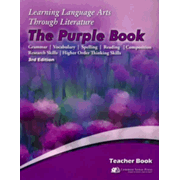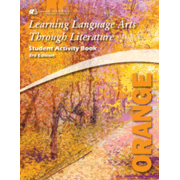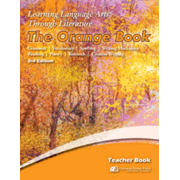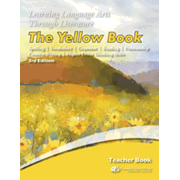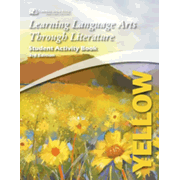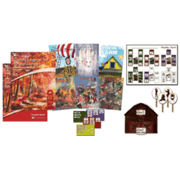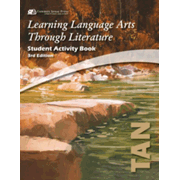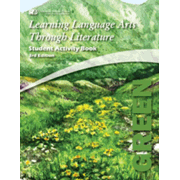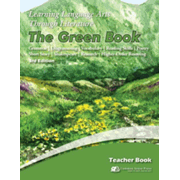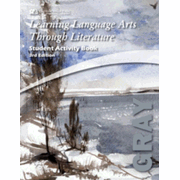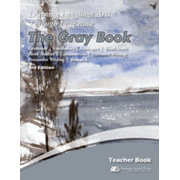Learning Language Arts Through Literature (LLATL), a comprehensive language arts curriculum, is based upon Dr. Ruth Beechick’s ideas about how to best teach young children—ideas that have much in common with Charlotte Mason’s. The third editions of these courses (2017) are better than ever. The program actually begins with the Blue Book, a beginning phonics program that I review under reading programs. LLATL continues to do a great job with comprehensive coverage of language art skills in these courses for grades two through eight with a shift toward the broader range of language arts now that students are past the beginning reading stage. Books for each grade are identified by colors: Red, Yellow, Orange, Purple, Tan, Green, and Gray for grades two through eight respectively.
One of the key features of LLATL is literature—in the form of both short excerpts and complete novels—used as a springboard into other areas of language arts. In earlier editions, studies of novels were awkwardly placed in some of the courses. I was pleased to see that the third edition courses have remedied that issue by rearranging lessons to allow appropriate time for reading each novel in preparation for some of the related activities. The use of literature motivates greater interest in both the lessons and the novels themselves.
In the notes on each course below, I point out only the features unique to each course. This includes the literary selections that are used for a substantial part of the course work.
Focus shifts from emphasis on developing reading skills in the early grades to more work with composition and literature at upper levels. A Skills Index at the back of each teacher book shows which skills are covered on which pages. Whatever the level, aside from the novels to be read, students will work in only one student activity book for the various areas of language arts rather than having separate books for reading, language, spelling, and vocabulary.
Grammar, spelling, vocabulary, composition, research, and other skills all receive extensive attention. Following recommendations by Dr. Beechick, once children are able to write independently, they copy short passages from prose and poetry and also take them by dictation. Occasionally, a literary passage with unusual spellings or punctuation will be studied first, then taken by dictation a few days later after students have been alerted to unusual features. In both cases, the ensuing lessons frequently refer back to the literary passage for the week (e.g., identify personal pronouns in the passage). Student activity books have lots of variety, and this helps stimulate and maintain students’ interest.
Note that printing is taught in the first few levels, then cursive handwriting is taught in the Yellow Book. Handwriting is not included beyond the Yellow Book, so you will probably need to incorporate additional cursive practice activities for the Orange Book and above.
Student activity books for each course are essential since they contain numerous workbook-type assignments, periodic reviews and assessments, and some pages that need to be cut out for activities. You will also need to buy or borrow novels that are used for most of the courses.
Each course has 36 lessons and should take about one school year to complete if you use lessons daily. Although books are suggested for particular grade levels, once past the first year or two, you should be able to use the same level with children over a two to three year grade span.
The LLATL program was designed for home educators and provides instructions as needed along the way. It is easy to just pick up the teacher's guide and work through lessons with minimal (if any) lesson preparation. Younger students will need more instruction, but students in fourth grade and above should be able to do half or more of their work independently. A parent or teacher needs to give dictation, work with students to determine which spelling words need attention, give spelling tests, or sometimes discuss a question with the student, so some interaction will always be required. Periodic assessments are in the student activity books. Answers for both lesson activities and assessments are in the teacher’s books.
This is a great program for homeschoolers who want to use something other than traditional textbooks but are stymied as to how to accomplish this. It is also a very efficient way to cover the broad swath of language arts skills.
The LLATL books are written by Christians and reflect Christian values, but overtly Christian content is rare in all courses except the Gray Book.
The Red Book package - 2nd grade
The course for this level comes in a boxed set containing the teacher manual, student activity book, and readers, although you can also purchase books individually. Although six illustrated readers come with the program, you will need to borrow or purchase ten additional children’s books such as Little Bear, Corduroy, and Billy and Blaze. (The inclusion of the illustrated readers is the reason this course comes in a package, unlike the rest of the courses.)
While lessons are multi-sensory and interactive, students will occasionally work on assignments in the student activity book on their own. Instruction covers beginning composition skills, handwriting (printing), grammar, reading comprehension, spelling, critical thinking, and beginning research and study skills, along with a review of phonics. However, if a child has already mastered phonics, you might skip those parts of the lessons and focus on new material instead. Periodic assessments help parents/teachers determine how well students are progressing.
Handwriting activities need to be adapted for the student or skipped. In the student book, instructions ask students to write full sentences from the very first lesson in the book. However, the teacher book says in each of these instances: "[A]sk your student to write or dictate a sentence." Other lesson activities direct students to write words as well. At second grade level, many students will already be able to print fairly well, and they will be able to complete written activities without a problem. However, Lesson 5 has students begin tracing and copying individual letters and two-letter words for handwriting practice as if this is something new to learn. If a child can already print, you might skip those activities. In fact if a child cannot already print, I would wait to start them in the Red Book since it requires quite a bit of handwriting. If a child struggles with writing, you can always provide help as needed. You might want to use another resource for developing handwriting skills if children need it since the handwriting instruction in the Red Book is not very extensive.
A number of pages, printed on only one side, are to be removed from the book and used for activities. With these pages, students will do cut-and-paste activities, cut out and use bingo cards and word strips, fold pages into small books, create flip books, and other such activities. One minor complaint: flip books that are to be cut out and put together could use a little more explanation as to how to put them together.
The Red Book provides a great alternative to traditional workbooks and programs that isolate subjects and skills. It should be fairly easy for even beginning homeschoolers to use.
Yellow Book - 3rd grade
The broad range of language arts skills covered at this level includes grammar, composition, cursive handwriting, spelling, listening, oral presentation, dictionary skills, and critical thinking.
Four Literature Link units interspersed throughout the book offer two options: read the recommended book and work with questions and activities that refer to the book, or read the lengthy alternate passage included within the text and use the appropriate questions. The four recommended books for these units are The White Stallion, Madeline, Meet George Washington, and The Courage of Sarah Noble.
Extra enrichment activities found in the student activity book (e.g., analogies, word puzzles, projects, critical thinking, and grammar activities) can be used for challenge or enrichment.
Orange Book - 4th grade
Four books are used as literature sources at this level: The Boxcar Children, Wilbur and Orville Wright, Ben and Me, and The Sign of the Beaver. Four weeks of lesson material is constructed around each book. For each of these books, three lessons draw on excerpts from the book as students work on vocabulary, grammar, spelling, use of a thesaurus, editing, and composition skills. During these three weeks, students will also be reading the entire book in preparation for a fourth lesson that includes questions and activities relating to the book.
Periodically, students either copy short literary excerpts or write them from dictation, depending upon their abilities. Units on research, journal writing, poetry, newspaper writing, and story writing/book making are interspersed between the book studies to fill in another 20 week's worth of lessons.
Purple Book - 5th grade
The four books studied this year are Farmer Boy, Trumpet of the Swan, Number the Stars, and Caddie Woodlawn. Some additional reading material such as Longfellow's poem "Paul Revere's Ride" is included in the student activity book. Students focus particularly on oral presentations, poetry, tall tales, folk tales, and speech making. As is appropriate for this level, the student activity book requires more writing, especially in the latter part of the course. Enrichment activities found only in the student book (and not in the teacher's manual) stretch into research, analogies, and logic.
Tan Book - 6th grade
This year the four books studied are Carry On, Mr. Bowditch; The Bronze Bow; Big Red; and The Horse and His Boy. Students also encounter excerpts from other literature such as Prince Caspian, Ivanhoe, and Swiss Family Robinson that are used for copywork, dictation, and other lesson activities. There are special units on research and writing the research essay. Lessons are increasingly challenging as students work through activities for reading, literary analysis, grammar, composition, vocabulary, spelling, and critical thinking.
Green Book - 7th grade
The Green Book covers grammar (including diagramming), poetry, book study, creative writing (including a short story), topic studies, speech making, and research papers. Literary passages from books such as Black Beauty, The Borrowers, and Eight Cousins are the foundation for study in many lessons. Other books and a play required for book studies lasting a few weeks or more are Star of Light, The Mysterious Benedict Society, and Shakespeare’s Much Ado About Nothing. In a six-week poetry unit, students will learn to appreciate and analyze poems, and they will also memorize, recite and write poems.
Composition and grammar skills receive the most attention in the Green Book, although all concepts typically taught in seventh-grade language arts are covered. Reading skills (comprehension, recognition and use of literary devices, structures, etc.) are taught explicitly, while vocabulary work is integrated throughout the lessons. Spelling receives some attention, with an emphasis on rules and generalizations. Study and research skills are also incorporated into lessons.
The Gray Book - 8th grade
This book shifts students to a more challenging level of work, especially in the areas of writing and critical thinking. Similar in format to other books in the series, this course includes dictation, grammar, spelling, vocabulary, analogies, composition work, and four book studies.
In many of the lessons, passages from well-known literature are dictated to students. (If this is too challenging, have them copy passages first, then write them from dictation.) In addition, students work on spelling from a list of the most commonly misspelled words (found at the back of their book) coupled with their own list of troublesome words they encounter. Grammar activities and exercises in each lesson often tie in with the dictated passage. Frequent writing assignments develop composition skills, but a special five-week unit on writing teaches students to write four lengthier papers: a narrative essay, a persuasive essay, a comparison/contrast essay, and a research paper. Four book-study units are interspersed between other lessons. The four books students will read are Daddy Long Legs, A Lantern in Her Hand, Eric Liddell, and God’s Smuggler. The student activity book includes basic spelling, capitalization, and comma rules in the appendix, and students are expected to use these as reference tools.
A Christian viewpoint is more evident in the Gray Book than others. For example, a number of biblical passages as well as quotes from Christian literature are used for dictation, and two of the books to be read are clearly Christian.





